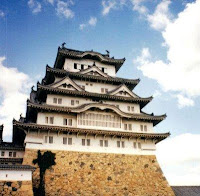Burning Barge Ritual – Bagan Siapiapi, Call of the Sea God is such a thrill in the heart!
 One of the local traditions and beliefs in Chinese society community in Bagan Siapi-api, Rokan Hilir, Riau has been going on a hundred-year time span, a ritual! Burning Barge Ritual that was held on 15-16 month of the fifth Chinese Imlek calendar is called Go Gwee Cap Lak.
One of the local traditions and beliefs in Chinese society community in Bagan Siapi-api, Rokan Hilir, Riau has been going on a hundred-year time span, a ritual! Burning Barge Ritual that was held on 15-16 month of the fifth Chinese Imlek calendar is called Go Gwee Cap Lak. The annual ritual as a means of calling back home to their native-born this year in the third week of June 17-18, 2011, traditions and beliefs of Chinese citizens continue to be treated every year, far more lively than the celebration of Chinese New Year, Cap Go Meh. The specificity of the celebration of Go Gwee Cap Lak is located on procession of burning barge that became an integral part of the historical presence of Chinese citizens in Bagan Siapiapi, Riau.
 Rituals are closely presence of the Kelenteng (Confucianism Temple) Ing Hok Kiong is a place of tribute worship to the God Kie Ong Ya and God Tai Sun Ong Ya as a manifestation of the god who gives salvation and prosperity for the Chinese community in Bagan Siapiapi.
Rituals are closely presence of the Kelenteng (Confucianism Temple) Ing Hok Kiong is a place of tribute worship to the God Kie Ong Ya and God Tai Sun Ong Ya as a manifestation of the god who gives salvation and prosperity for the Chinese community in Bagan Siapiapi.Many people initially do not know how the origins of this ritual and invite the admiration of all the procession carried on by them, especially in the celebration earlier this week, June 18, 2011. A unique procession, burning barge ritual making tens of thousands of people from different regions and countries come to see it.
 "Strange to see the participants of this ceremony, they are so reverent and honoring ancestors, though now the world was more modern. Look at all the peaceful and diverse races and ethnicities co-witness," said a tourist from Singapore.
"Strange to see the participants of this ceremony, they are so reverent and honoring ancestors, though now the world was more modern. Look at all the peaceful and diverse races and ethnicities co-witness," said a tourist from Singapore. A tradition that invites the public interest in many different countries after learning of this terrible event took place, a tradition of inter-nation tour of the more widely known to the public.
 Ang Mie Kui from Fujian, China in 1820 led a group of his family left the mainland to change the fate of luck in another country, because the famine in their country. Before starting a long journey, they brought a statue of God King Ong Ya and God Tai Sun Ong Ya, by the wood barge they across the ocean and struggling to survive amid safely to a dream land. They had lived in the village Sonkla, Thailand. Did not last long, because the social unrest of that era made them have to go looking for other purposes. Back to the middle of the ocean atrocities, continued to look for land sailing.
Ang Mie Kui from Fujian, China in 1820 led a group of his family left the mainland to change the fate of luck in another country, because the famine in their country. Before starting a long journey, they brought a statue of God King Ong Ya and God Tai Sun Ong Ya, by the wood barge they across the ocean and struggling to survive amid safely to a dream land. They had lived in the village Sonkla, Thailand. Did not last long, because the social unrest of that era made them have to go looking for other purposes. Back to the middle of the ocean atrocities, continued to look for land sailing. Amid the confusion floating in the ocean, visible from a distance the twinkling lights of the nocturnal, fireflies in the night as the fire were scattered on the black sky, the land. They pray to give thanks to god, then immediately burn the barges that they bring as a greeting and prayer of gratitude. They began farming and settled in the village of Bagan, hereinafter referred to as Bagan Siapi-api that lies at the mouth of the river Rokan, Riau. They built the Kelenteng (temple) Ing Hok Kiong as a form of gratitude to the god in 1826. Until now the temple become the center of religious beliefs and traditions of Confucianism.
Amid the confusion floating in the ocean, visible from a distance the twinkling lights of the nocturnal, fireflies in the night as the fire were scattered on the black sky, the land. They pray to give thanks to god, then immediately burn the barges that they bring as a greeting and prayer of gratitude. They began farming and settled in the village of Bagan, hereinafter referred to as Bagan Siapi-api that lies at the mouth of the river Rokan, Riau. They built the Kelenteng (temple) Ing Hok Kiong as a form of gratitude to the god in 1826. Until now the temple become the center of religious beliefs and traditions of Confucianism.For all the history of their ancestors, even as their descendants have spread far away from the homeland, to Singapore, Australia, Taiwan, Malaysia, the UK and many countries, they always come back to attend the annual Burning Barge Ritual as a manifestation of love and salvation to the ancestors.
"Such a thrill in my heart is calling, longing to go home," said one participant.
-------------------------------------------------- ---
(Various sources Kompas /Image Imam Hartoyo)


Comments
Post a Comment